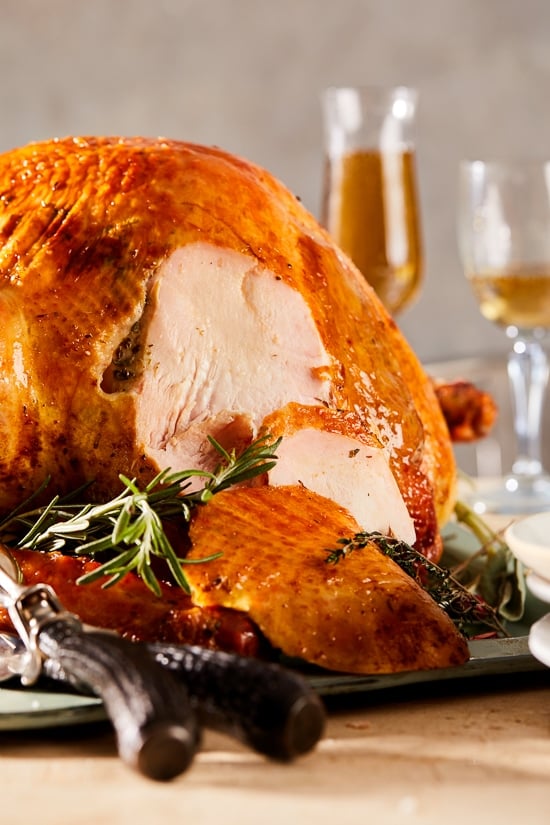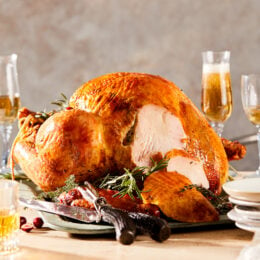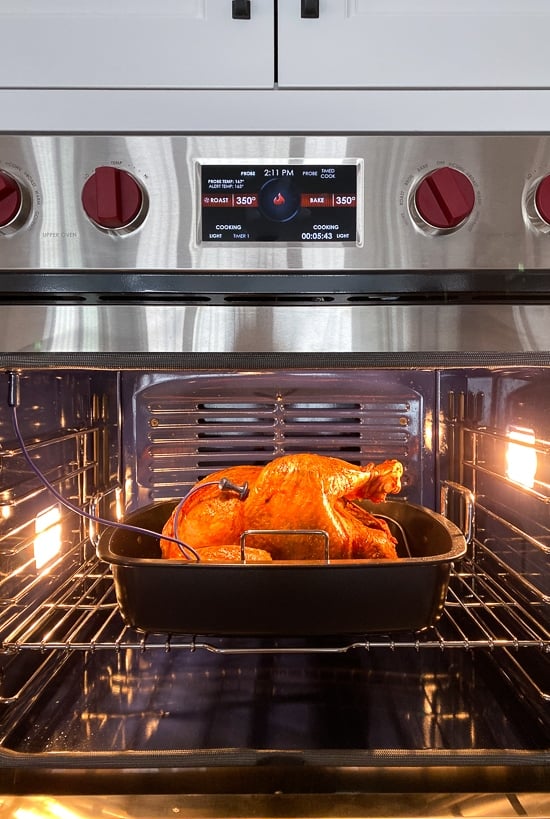This Herb and Salt-Rubbed Dry Brined Turkey comes out so moist and flavorful, with crispy golden skin and juicy tender meat.

Herb and Salt-Rubbed Dry Brine Turkey
Want an easy roast turkey recipe that’s moist and flavorful? Try dry brining! Rather than wet brining a turkey, dry brining is so much easier and less messy! This is how I am making my turkey again this year, my third year in a row! It’s seasoning with salt and fresh herbs and comes out wonderful. It takes 4 days to brine, but I am starting one day late (today) which is perfectly fine! And if you don’t need to make a whole turkey, you might love this stuffed turkey breast or this slow cooker turkey breast recipe.
Choosing the right size Thanksgiving turkey
A good rule of thumb is to estimate at least 1 lb to 1 1/2 lbs per person so you’ll have extra and enough for leftovers.
Fresh or Frozen?
Whether you use a fresh or frozen turkey for dry-brining, start with a bird that has no seasoning in it at all. Avoid kosher turkeys, which have been pre-salted, as well as self-basting turkeys, which have been injected with a salt solution.
Fresh – One of the pros of using a fresh bird is there’s no need to thaw. A fresh bird will keep for 4 days in the fridge. Some people think it’s more flavorful than a frozen bird.
Frozen – Typically more affordable and can be purchased weeks in advance. It does however require thawing time. If the turkey is frozen solid when you buy it, it will need approximately 24 hours for every 5 pounds of turkey to thaw completely. For quicker thawing, place the turkey in a cold water bath and change the water every 30 minutes until it’s thawed.
Defrosting a turkey
Fridge – if you have more time, allow the turkey to thaw in the fridge in it’s original packaging. Allow 24 hours of thawing for every 5 lbs of bird.
Cold Water Bath – If you’re short on time, submerge the bird in a cold water bath changing the water every 30 minutes. Allow 30 minutes of thawing time per pound of bird.
What is a dry brine?
A dry brine is an herb and salt rub applied directly to the turkey. This creates satiny leg meat and juicy, perfectly seasoned breast meat. Air-drying the turkey on the last day of the 4-day process will make the skin crisp when roasted.
Dry Brine Turkey Spices and Variations
You can play around with the herbs and spices and add garlic powder, lemon zest, black pepper, dried bay leaf, etc.
How much salt should I use?
This recipe can be adapted to turkeys of all sizes. Use 1 tablespoon of salt for every 4 pounds. Diamond Crystal salt is best, Morton’s has more sodium and will be saltier. If using Morton’s, you will have to adjust and use less.
Kosher Salt
The only salt I cook with every day is Diamond Crystal kosher salt. Note that different brands and different types of salt vary not only in the amount of sodium per measured amount, but also for taste. When cooking the recipes from my website and cookbooks—both for flavor and for the sodium values listed—you should use Diamond Crystal kosher salt. If you use another type of salt or a different brand of kosher salt, just remember to taste as you go.
Storing
Leftovers should be put away when you’re done serving. Store leftover meat and the turkey carcass for up to 4 days or frozen for up to 3 months.
It feels like we’ve been remodeling our new home forever, but this week I finally got to cook in my new kitchen and put my new Wolf M series double oven to the test. Needless to say, I am IN LOVE!! I went big for the first time and cooked a whole 16-pound turkey as a test run for Thanksgiving along with a few side dishes. Using this oven was everything I imagined and more!
The oven has a variety of programmed cooking modes, but for this particular recipe, I tried the Convection Roast mode which cooked the turkey in a fraction of the time! (I tested this recipe both in my old oven on conventional roast and my new Wolf oven on convection roast to see how they compared). What’s more, it’s the most spacious oven I’ve ever had (it’s actually Wolf’s largest capacity oven), so between the two of them I’m able to fit more dishes at the same time than ever before.
But the feature I think I loved best for making a turkey was the temperature probe. It takes the guesswork out of knowing if the turkey is ready and you can even download an app on your phone to monitor the meat’s cooking progress without having to open the oven door! To use the probe, I simply inserted it into the turkey thigh right between the leg and the thigh away from the bone and set the temperature to 170F. Once the turkey hit the correct temperature, it notified me it was ready. No guessing! I let it rest 30 minutes which brought the temp up a little more. The turkey was so moist and juicy, the skin so crisp and flavorful, this is how I will be making my turkey for years to come!
Leftover Turkey Recipes
- Open Faced Turkey Melts
- Leftover Turkey Sweet Potato Frittata
- Turkey Mashed Potato Pot Pie
- Leftover Turkey Harvest Cobb
- Turkey Pot Pie Soup
Your comments are helpful!! If you’ve tried this dry brine turkey recipe or any other recipe on Skinnytaste, don’t forget to rate the recipe and leave me a comment below! And if you took some photos of video, share it with me on Instagram or Tiktok!
Herb and Salt-Rubbed Dry Brine Turkey

Ingredients
- 2 tablespoon chopped fresh thyme
- 2 tablespoon chopped fresh sage
- 1 tablespoon chopped fresh rosemary
- 1 tablespoon dried marjoram
- 1/2 tablespoon dried oregano
- 1 tablespoon extra-virgin olive oil
- 1 thawed or fresh 16-lb turkey, preferably fresh (not kosher or self-basting) if frozen, thaw before
- 1/4 cup Diamond Crystal Kosher Salt, use less with Mortons
Instructions
4-Day Dry Brine:
- (4) Four days before you plan to roast the turkey, mix the herbs and oil in a small bowl. Remove the neck and giblets and reserve for stock, if using. Loosen the skin around the shoulders of the bird and around the cavity. Carefully slide your hands underneath the skin to loosen it from the breast, thighs, and drumsticks.
- Combine olive oil and herbs. Rub the herbs on the meat, under the skin. Pat the skin back into place.
- Rub the salt inside the cavity and on the skin. Tuck the wing tips behind the neck and tie the legs together with kitchen twine. Put the turkey in a large food-safe plastic bag (such as a turkey-size roasting bag) and tie. Put the bag inside a second bag and tie.
- Day 1 to 3: Place on a rimmed baking sheet and refrigerate the turkey, turning it over every day, for 3 days.
- Day 4: Remove the turkey from the bags and pat dry with paper towels. Transfer to a large roasting pan and refrigerate, unwrapped, to let the turkey air-dry overnight (for the fourth day).
Roast turkey (Day 5):
- Remove the turkey from the refrigerator and let it temper on the counter for about 1 to 3 hours. Place turkey breast side up on a rack (sprayed with oil) in a shallow roasting pan 2 to 2½ inches deep.
Convection Roast Mode:
- Position a rack in the bottom third of the oven and preheat the oven to 350°F in convection roast setting. If using a probe, insert the thermometer in the thickest part of the thigh not touching the bone and set the temp to 170F. Roast until the temp registers 170°F in the thickest part of a thigh, about 1 1/2 to 2 hours, or longer depending on the size of the turkey. Let the turkey rest for 30 minutes before carving to allow the juices to settle.
Conventional Oven:
- Position a rack in the bottom third of the oven and preheat the oven to 425°F. Roast the turkey for 1 hour, then reduce the heat to 325°F.
- Continue to roast until an instant-read thermometer registers 170°F in the thickest part of a thigh, about 1 3/4 to 2 hours. Let the turkey rest for 30 minutes before carving to allow the juices to settle.
Last Step:
Please leave a rating and comment letting us know how you liked this recipe! This helps our business to thrive and continue providing free, high-quality recipes for you.Video
Notes
Nutrition
Disclosure: This post is created in partnership with Sub-Zero Wolf. All thoughts are my own.








